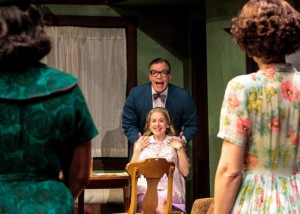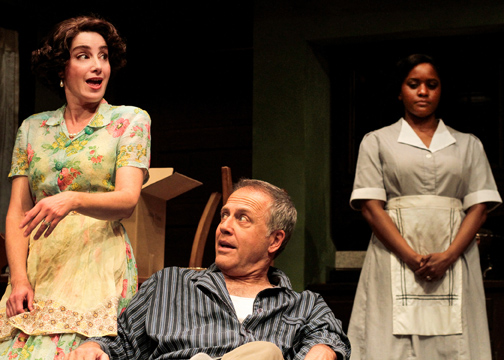I’ll admit, I’m not a “play-watching” person—Musicals are more my speed. But when I got the opportunity to watch the Tony Award-winning comedy, “Clybourne Park,” I thought I’d give it a go and see if I can enjoy a play. Like I expected: no flashy sets, no major scene transitions, a lot of talking. However, I got sucked into the story…
“Clybourne Park” is billed as, “a comedy about race, class and real estate in America.” The storyline is centered around the famous fictional house from Lorraine Hansbury’s play from 1959, “A Raisin in the Sun” where a white couple sells their home to a black family and causes racial tension in the neighborhood. “Clybourne Park” recreates that moment in 1959 (Act I) and also gives us a glimpse of 50 years into the future (Act II) of that same house.
In Act I, the actors portrayed stereotypical characters: The white home-sellers, Russ and Bev (Mark Pinter and Sandy Campbell) who are concerned about their chafing dishes and name origins of “Napoleon Ice Cream”; A black house maid, Francine (Monique Gaffney) and her husband, Albert (Matt Orduña) who unintentionally gets involved as he picks his wife up from work; Jim (Jason Maddy), a pastor and neighbor/confidant of Bev; Karl (Jason Heil) and his deaf and pregnant wife, Betsy (Amanda Leigh Cobb), the white “neighborhood representative” who is trying to undermine the sale of the house.

The characters were mostly convincing. I don’t know if a lot women in the late 50’s had that “Lucille Ball” vibe to them, but that’s how I felt about Bev. The moment you like one of the characters, they say or do something that immediately turns that fondness around. Well, except for Betsy, who was a bit of comic relief (But I hung my head in shame that I’m laughing at the portrayal at a deaf woman). In the end of Act I, we faced the inevitable — change was going to happen.
And change it did…
Forward to Act II where we find ourselves in the same house, yet it seems to have been neglected and taken over by vandals. Roles are reversed and we now find a white couple, Steve and Lindsey, moving into that same house except the neighborhood has transformed into a black community. Steve and Lindsey are attracted to the house’s “charm” and would like to remodel it but the “neighborhood representatives” are more concerned over the historic value of the home. The racial tensions are different this time around. People are more accepting of each other, yet there’s this underlying racism and naivety among all the characters. You will find yourself laughing yet in shock that you’re laughing. But I won’t give too much away — you’ll have to see it.
After seeing this play, I couldn’t help think about the neighborhood I grew up in. It was considered the “suburbs.” But then the “city” creeped in on us and the area around us became “urban.” Yes, the the neighborhood I was raised in was primarily white in the late 50’s and 60’s. But it slowly shifted to a primarily black and Latino population by the time I was brought to this earth. Will it change again? Maybe.
All in all, “Clybourne Park” is relatable. It will cause personal introspection of race and also leave you with an understanding that time does cause change. The question is, are we ready to embrace change?
The San Diego Rep is showing “Clybourne Park” through February 10, 2013 at the Lyceum Stage in Horton Plaza. Tickets run from $38-$43 on the San Diego Rep’s website and really, every seat is a good seat!
Disclosure: I received tickets to watch the show. In no other way was I compensated for a review. All opinions stated here are my own.


